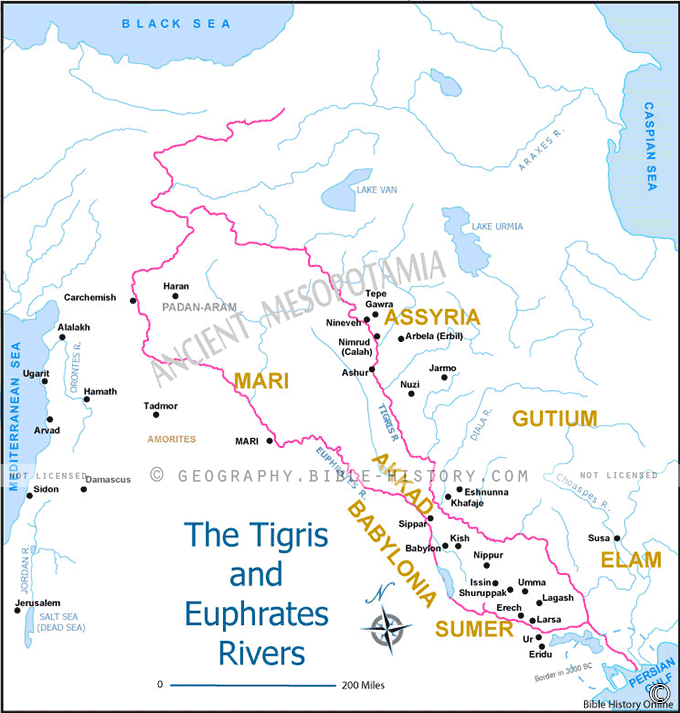
The Map of the Tigris and Euphrates Rivers unveils a geographic canvas that serves as the birthplace of human civilization. These two ancient rivers, winding through the vast region of Mesopotamia, have nourished societies, cultures, and empires for millennia, shaping the course of history in profound ways.
The Fertile Crescent
The Tigris and Euphrates Rivers converge to form the region known as the Fertile Crescent. This crescent-shaped land, with its fertile alluvial soil, became the cradle of agriculture. Here, the earliest human settlements emerged, and the foundations of agriculture, writing, and organized society were laid.
Mesopotamia: The Land Between the Rivers
The term "Mesopotamia" itself means "between the rivers," emphasizing the significance of this region. The Tigris and Euphrates served as life-giving arteries, enabling agriculture to flourish and populations to grow. City-states like Ur, Uruk, and Babylon thrived along their banks.
The Birth of Writing and Law
Mesopotamia witnessed the emergence of some of humanity's greatest innovations. Cuneiform script, one of the earliest writing systems, was developed here, allowing for record-keeping, literature, and communication. The Code of Hammurabi, one of the earliest known legal codes, was etched into a stele in Babylon, providing insights into early legal systems.
Ancient Empires and Trade Routes
The Tigris and Euphrates served as crucial transportation routes and facilitated trade between Mesopotamia and other civilizations. The region was at the crossroads of empires, with the Sumerians, Akkadians, Assyrians, Babylonians, and Persians all leaving their marks on its history.
Religious Significance
The region is also of immense religious importance. Ancient Mesopotamia was home to a pantheon of deities, and its myths and stories influenced subsequent religious traditions, including those of Judaism, Christianity, and Islam. The biblical Garden of Eden is traditionally associated with this area.
Modern Significance
Today, the Tigris and Euphrates Rivers remain vital to the countries they flow through, including Iraq and parts of Turkey, Iran, and Syria. They provide water for agriculture and serve as a source of life and livelihood for millions of people.
The Map of the Tigris and Euphrates Rivers takes us on a journey through the cradle of human civilization. It reveals a landscape that nurtured early societies, fostered innovation, and left an enduring legacy on culture, religion, and the very foundations of human history.
Blank Topo Map of The World
Abraham’s Journey
The Captivity of Judah (586-516 B.C.)
The Fall of Judah 586 B.C.
The Northern Kingdom of Israel
The Southern Kingdom of Judah
The Divided Kingdom
The Fertile Crescent
Ur of the Chaldees
Shechem in Old Testament Times
Prophets, Kings, and Nations
Jesus Last Passover
New Testament Israel
New Testament Places
Old Testament Israel
Provinces of the Roman Empire
Israel during David’s Kingdom
David’s Kingdom
Cities of the New Testament 4
Cities of the New Testament 3
Cities of the New Testament 2
Mediterranean Sea
Cities of the New Testament
First Century Jerusalem
Empire of David and Solomon
David’s Kingdom
Israel Under Rehoboam
Ophir and Tarshish
The Period of the Kings
Ramoth Gilead
Samaria
Solomon’s Temple
Zarephath and MT Carmel
Jabesh Gilead and Tribes
Judah in the Time of David
Kingdom of Saul
Kirjath Jearim
Michmash
Mount Gilboa in the Time of David
Nob Davids Flight
Shiloh
Israel and Judah
Assyrian Empire Under Esarhaddon
Assyrian Empire Under Sennacherib
Captivity of 10 Tribes
Events in 2 Kings
The Khabur River
Israel and Syria
Captives From Judah
Kingdom of Jeroboam
Mesha’s Kingdom
Pharaoh Necho Battles King Josiah at Megiddo
Babylonian, Mede and Persian Empires
Samaria and Nearby Territories
Syria at its Height
Hebron
Mahanaim
1949 Map of Israel With Boundaries
First & Second Journeys of Paul
Journeys of the Apostles
Paul’s Third Missionary Journey
Saul’s Journey to Damascus and Arabia
Paul’s Final Visits
Paul’s 1st Missionary Journey
Paul’s 2nd Missionary Journey
Paul’s 3rd Missionary Journey
Paul’s Voyage to Rome
Phillip Journeys to Samaria and Gaza
Judah at the Time of Amos
Empire of Alexander the Great
Israel Under the Maccabees
Galilee During Maccabees
Idumea Intertestamental Period
Kingdom of the Ptolemies
Kingdom of the Seleucids
Ptolemaic Egypt Seleucid Asia
The Roman World
Kingdom of Ptolemies and Seleucids
The World During the 6TH Century BC
Mount Horeb
The Red Sea
The Exodus
Ezra’s Journey to Restore Jerusalem
Israel and Judah During Hosea’s Time
The Ancient World
Canaan During the Time of Abraham
The City of Shechem
Supposed Location of the Garden of Eden
The Land of Israel in Genesis
The Jordan River
The Kingdom of Nimrod
Mount Ararat and Mesopotamia
The Descendants
Sodom and Gomorrah
The Kingdom of Egypt
The Hamites
The Kingdom of the Hittites
Ur of the Chaldees
Judah at the Time of Haggai
Jesus Passes Through Samaria
